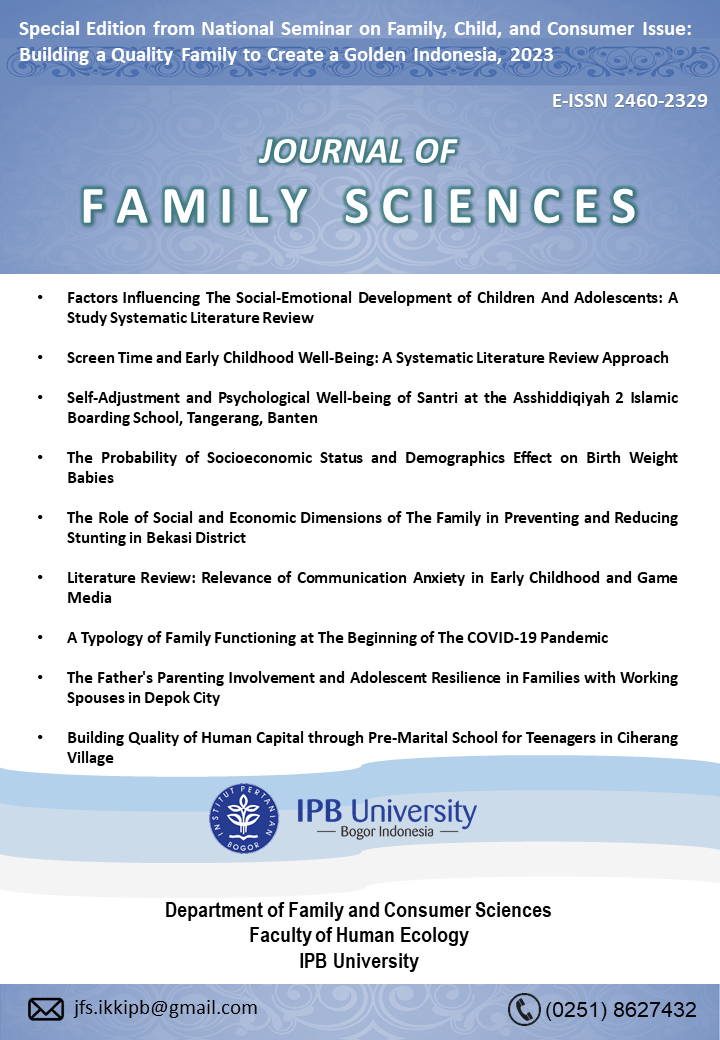Building Quality of Human Capital through Pre-Marital School for Teenagers in Ciherang Village
Abstract
The number of child marriages in Indonesia continues to increase and Indonesia is in the top 10 with the highest number of child marriages in the world. Pre-Marital School is a non-formal learning about marriage preparation for adolescents to gain knowledge and readiness before entering family life. The objectives of the Pre-Marital School are to reduce the high rate of child marriage, change adolescents' perception of family welfare, increase adolescents' knowledge related to family welfare and family functions, family nutrition, and improve family welfare. This study used action research method, which is organizing measurable action activities for teenagers in Ciherang Village, Bogor Regency, West Java. The number of participants involved was 16 teenagers. The data collected were pre-test and post-test data. The data was processed with SPPS by looking at the average change in knowledge. The results show that there has been a change in adolescents' perceptions about the importance of forming a prosperous family, an increase in adolescents' knowledge about the minimum age of marriage, indicators of prosperous family stages and family functions, and an increase in knowledge about family nutrition in adolescents. The success of this program shows that it is necessary to re-conduct similar programs that can be carried out in other areas. It is hoped that this program can reduce the number of child marriages in Indonesia.
Downloads
References
[BPS] Badan Pusat Statistik. (2021). Indikator Kesejahteraan Rakya 2021. Jakarta(ID): BPS
Arbelia, C., & Riany, Y. E. (2022). Economic Pressure, parent-adolescent interaction, and early marriage motivation. Journal of Child, Family, and Consumer Studies, 1(3), 209–219. https://doi.org/10.29244/jcfcs.1.3.209-219
Khusna, N. A., & Nuryanto, N. (2017). Hubungan usia ibu menikah dini dengan status gizi batita di Kabupaten Temanggung. Journal of Nutrition College, 6(1), 1–10. https://doi.org/10.14710/jnc.v6i1.16885
Badan Perencanaan Pembangunan Nasional, Badan Pusat Statistik, UNICEF, dan Pusat Kajian dan Advokasi Perlindungan dan Kualitas Hidup Anak Universitas Indonesia. (2020). Pencegahan Pernikahan Anak: Percepatan yang Tidak Bisa ditunda. Jakarta(ID): BPS, Bappenas, UNICEF, dan PUSKAPA.
Dwinanda, A. R., Wijayanti, A. C., & Werdani, K. E. (2015). Hubungan antara pendidikan ibu dan pengetahuan responden dengan pernikahan usia dini. Jurnal Kesehatan Masyarakat Andalas, 10(1), 76–81. https://doi.org/10.24893/jkma.v10i1.166
Fadlyana, E., & Larasaty, S. (2016). Pernikahan usia dini dan permasalahannya. Sari Pediatri, 11(2), 136-41. https://doi.org/10.14238/sp11.2.2009.136-41
Gainau, M. B. (2015). Perkembangan Remaja dan Problematikanya. Yogyakarta(ID): PT Kanisius.
Ghalili, Z., Etemadi, O., Ahmadi, S. A., Fatehizadeh, M., & Abedi, M. R. (2012). Marriage readiness criteria among young adults of Isfahan : A qualitative study. Journal of Contemporary Research In Business, 4(4), 1076–1083.
Gunarsa., Singgih, D. (2008). Psikologi Anak: Psikologi Perkembangan Anak dan Remaja. Jakarta(ID): PT BPK Gunung Mulia
Herawati, T., Pranaji, D. K., Pujihasvuty, R., & Latifah, E. W. (2020). Faktor-faktor yang memengaruhi pelaksanaan fungsi keluarga di Indonesia. Jurnal Ilmu Keluarga Dan Konsumen, 13(3), 213–227. https://doi.org/10.24156/jikk.2020.13.3.213
Hurlock, E. B. (1980). Psikologi Perkembangan: Suatu Pendekatan Sepanjang Rentang Kehidupan (R. M. Sijabat (ed.); 5th ed.). Jakarta(ID): Erlangga.
Indrijati, H. (2017). Penggunaan internet dan perilaku seksual pranikah remaja. Prosiding Temu Ilmiah X Ikatan Psikologi Perkembangan Indonesia, 17, 44–51.
Juhaidi, A., & Umar, M. (2020). Pernikahan dini, pendidikan, kesehatan dan kemiskinan di indonesia, masihkah berkorelasi?. Khazanah: Jurnal Studi Islam Dan Humaniora, 18(1), 1-24. https://doi.org/10.18592/khazanah.v18i1.3585
Mustika, I., & Herawati, T. (2022). Determinant of marital quality in newly married couple during the covid-19 pandemic. Journal of Child, Family, and Consumer Studies, 1(3), 155–165. https://doi.org/10.29244/jcfcs.1.3.155-165
Ningrum, D. N. F., Latifah, M., & Krisnatuti, D. (2021). Marital readiness : Exploring the key factors among university students. Humanitas Indonesian Psychological Journal, 18(1), 65–74. https://doi.org/10.26555/humanitas.v18i1.17912
Nurhikmah, Carolin, B. T., & Lubis, R. (2021). Faktor-faktor yang berhubungan dengan pernikahan usia dini. Jurnal Kebidanan, 7(1), 17–24. https://doi.org/10.33024/jkm.v7i1.3110
Rahman, F., Syahadatina, M., Aprillisya, R., & Afika, H. D. (2015). Kajian budaya remaja pelaku pernikahan di Kota Banjarbaru Kalimantan Selatan. Jurnal Mkmi, Juni 2015, 108–117.
Riyadi, H., & Sukandar, D. (2009). Asupan gizi anak balita peserta posyandu. Jurnal Gizi Dan Pangan, 4(1), 42–51. https://doi.org/10.25182/jgp.2009.4.1.42-51
Santrock J.W. (2019). Life-span Development. Seventeenth edition. New York(US): McGraw-Hill Education.
Sari, V. S., Suawarsito, & Mustolikh. (2015). Kajian faktor-faktor penyebab perkawinan usia muda dan dampaknya terhadap kondisi sosial ekonomi di Desa Lebakwangi Kecamatan Pagedongan Kabupaten Banjarnegara. Geoedukasi, 4, 1–10.
Sunarti, E. (2018). Modul Ketahanan Keluarga. In D. M. Nastiti (Ed.), IPB Press (1st ed.). Bogor(ID): IPB Press.
Wijayanti, U. T. (2021). Analisis faktor penyebab perceraian pada masa pandemi COVID-19 di kabupaten banyumas. Jurnal Ilmu Keluarga Dan Konsumen, 14(1), 14–26. https://doi.org/10.24156/jikk.2021.14.1.14
Authors who publish with this journal agree to the following terms:
- Authors retain copyright and grant the journal right of first publication with the work simultaneously licensed under

This work is licensed under a Creative Commons Attribution 4.0 International License. that allows others to share the work with an acknowledgement of the work's authorship and initial publication in this journal. - Authors are able to enter into separate, additional contractual arrangements for the non-exclusive distribution of the journal's published version of the work (e.g., post it to an institutional repository or publish it in a book), with an acknowledgement of its initial publication in this journal.
- Authors are permitted and encouraged to post their work online (e.g., in institutional repositories or on their website) prior to and during the submission process, as it can lead to productive exchanges, as well as earlier and greater citation of published work (See The Effect of Open Access).



_001.png)



